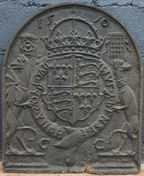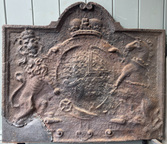-
41
Description: Arched rectangular shape; rope edging (top and sides); Tudor royal shield, garter, crown and supporters (crowned lion and dragon); date above crown; empty motto compartment with initials below.
Notes: Identical arms can be seen on fireback formerly at Baynards Park, Cranleigh (no. 200), and on one in private hands at Maresfield (no. 482), neither of which have the motto compartment; minor variations in the position of individual elements indicate that the garter and shield, crown, and each supporter were separately stamped; the initials are likely to be those of Henry Bowyer, ironmaster (d.1588), the fireback perhaps being made in his memory.
Inscription: 1588 HB
Arms: Tudor royal (Elizabeth I)
- Decoration tags:
- rectangular with round arch (shape)
- rope (edging)
- carved stamps
- individual letters
- individual numbers
- armorial
- royal
- text
- objects
Manufactured: in 1588 possibly at Pounsley Furnace, Framfield in the Weald area of England.
Current location: in private hands, Cuckfield, West Sussex, England.
-
52
Description: Arch-shaped, the arch consisting of eight, straight, ovolo-moulded sections; longer ovolo-moulded pieces form the lower sides of the fireback; in the centre a circular garter enclosing the Tudor arms of England; above, a crown; the date was carved on a single stamp and placed left of the crown.
Notes: From other examples it is apparent that the crown is formed from a separate stamp to the shield and garter. Formerly at Knole, Sevenoaks, and later at Horton Court Lodge, Monks Horton, Kent.
Copies of this fireback are known.
Inscription: 1589 / HONI SOIT qVI MAL I PANSE
Arms: Tudor royal
- Decoration tags:
- multi-facet arched (shape)
- ovolo (edging)
- carved stamps
- date stamp
- armorial
- royal
- text
Manufactured: in 1589 possibly in the Weald area of England.
Current location: Dartford Museum, Dartford, Kent, England.
Museum number: 1938-141 (part of the Dartford Museum museum group)
- Attached to series:
- 1589 series
- Tudor royal armorial firebacks
-
335
Description: Canted rectangle; stepped edging; unidentified shield with 12 quarterings, helm and crest; arms carved on rectangular back board.
Notes: Two horizontal plank lines; arms over-stamped. Photographed at Messrs. C. Pannett & Sons, Highgate, Hawkhurst, Kent; from an album of photographs of firebacks by W. Galsworthy Davie c.1912 (National Art Library, Victoria and Albert Museum, London).
Copies of this fireback are known.
Arms: Not known
- Decoration tags:
- rectangular with canted top corners (shape)
- rebated fillet (edging)
- carved pattern panels
- planklines
- armorial
Manufactured: in the late-16th to early-17th century possibly in the Weald area of England.
Current location: not known.
Citation: Shuffrey, L. A., 1912, The English Fireplace, London, Batsford.
- Attached to series:
- Personal armorial firebacks
-
266
Description: Arch-shaped, the arch consisting of eight, straight, ovolo-moulded sections; longer ovolo-moulded pieces form the lower sides of the fireback; in the centre a circular garter enclosing the Tudor arms of England; above, a crown; irregularly spaced each side of the shield, a crossed staple stamp (the left one over-pressed).
Notes: The crossed staple stamp suggests a connection with the Nevill family. The crown is formed from a separate stamp to the shield and garter. Other variants are dated 1589. Recorded at Penshurst Place in 1903; illustration from Dawson 1903.
Inscription: HONI SOIT qVI MAL I PANSE
Arms: Tudor royal
- Decoration tags:
- multi-facet arched (shape)
- ovolo (edging)
- carved stamps
- heraldic
- armorial
- royal
Manufactured: in the late-16th century in the Weald area of England.
Current location: not known.
Citation: Dawson, C., 1903, 'Sussex Iron Work and Pottery', Sussex Archaeological Collections, 46, pp. 1-54.
Citation: Gardner, J. S., 1898, 'Iron Casting in the Weald', Archaeologia, 56, 1, pp. 133-164.
- Attached to series:
- 1589 series
- Tudor royal armorial firebacks
-
267
Description: Rectangular; twisted rope edging (top and sides); top centre, crowned Tudor royal shield (over-pressed) between a leopard passant guardant sinister (on the left) and a leopard passant (on the right); below, crowned shield bearing initials, KH, above a fleur-de-lys, between two further leopards, styles as above; below the lower shield, two 'imp' figures, the left one with both arms lowered, the right with its right arm raised; outside each lower leopard, a crowned rose (over-pressed); each top corner, a pair of ‘imp’ figures styles as before.
Notes: One of the 'Royal' series. Illustration from Dawson 1903. Formerly in the collection of Dr C. Prince, of Crowborough, Sussex. Further deterioration at the bottom of the casting has caused some loss of metal.
Inscription: KH
Arms: Tudor royal arms of England
- Decoration tags:
- rectangular with canted top corners (shape)
- rope (edging)
- carved stamps
- heraldic
- armorial
- animals
- humans
- plants
Manufactured: in the mid-16th century in the Weald area of England.
Current location: Leeds Castle, Leeds, Kent, England.
Citation: Balcomb, J. T., Nov. 1886, 'An Extinct Sussex Art', The Art Journal, pp. 337-340.
Citation: Dawson, C., 1903, 'Sussex Iron Work and Pottery', Sussex Archaeological Collections, 46, pp. 1-54.
Citation: Gardner, J. S., 1898, 'Iron Casting in the Weald', Archaeologia, 56, 1, pp. 133-164.
- Attached to series:
- Royal series
-
268
Description: Rectangular; cavetto moulded edging; shield, garter, coronet, helm, crest, supporters and motto of Villiers, 1st Duke of Buckingham.
Notes: The arms are those of George Villiers (1592-1628), created Duke of Buckingham in 1623. Blazon: Quarterly 1, Villiers (modern) - argent, on a cross gules five scallops or; 2, Villiers (ancient) - sable, a fess between three cinquefoils argent; 3, Pakeman - gules, a chevron between three crosses botonnee fitchee argent; 4, Bellers - per pale gules and sable, a lion rampant argent crowned or; 5, Hoby - azure, a bend between six mullets argent; 6, Kirkby - argent, a cross between two annulets vert.
Copies of this fireback are known.
Inscription: HONI SOIT QVY MAL Y PENSE / FIDEI COTICULA CRUX [The cross is the touchstone of faith]
Arms: George Villiers, 1st Duke of Buckingham
- Decoration tags:
- rectangular (shape)
- cavetto (edging)
- whole carved pattern
- planklines
- armorial
Manufactured: in the early-17th century in England.
Current location: not known.
Citation: Dawson, C., 1903, 'Sussex Iron Work and Pottery', Sussex Archaeological Collections, 46, pp. 1-54.
- Attached to series:
- Personal armorial firebacks
- Bristol armorial series
-
893
Description: Rectangular with complex quasi-arched rectangular top; ovolo moulded edging; shield with Royal arms of France in a swirled cartouche, initials inserted at top of shield; above, an English crown; below to right and left, a prancing stag.
Notes: The combination of the English crown and French arms is common and may relate to the marriage of Charles I and Princess Henrietta Maria of France in 1625; although the framing of the pattern is very similar to others of the same basic design, the style suggests a different pattern maker. A recasting of an earlier back with inserted initials.
Copies of this fireback are known.
Inscription: IT
Arms: France modern
- Decoration tags:
- rectangular with round arch (shape)
- ovolo (edging)
- whole carved pattern
- armorial
- text
- animals
Manufactured: in the early- to mid-17th century possibly in the Weald area of England.
Current location: not known.
- Attached to series:
- Anglo-French armorial firebacks
-
1134
Description: Arched rectangular shape; astragal edging; central, vertically orientated, rectangular design comprising four circular copmpartments each containing a shield, surrounding an oval central compartment containing a castle surmounted by a crest of a hand between leafy branches all emerging from a mural crown, above is a crescent mark of cadency; the compartments are set within ears of corn with a flower head top and bottom centre.
Notes: The central design is a cast of the pattern for two panels, one on each of the pedestals of the outward-facing main columns on the Norwich Gates at Sandringham House, Norfolk. The shields are of Norfolk towns: (top left) Norwich, (top right) Great Yarmouth, (bottom left) King's Lynn, and (bottom right) Thetford. The central arms are those used by the county of Norfolk (before its official grant of arms in 1904) with the crest of the then Sheriff, Robert John Harvey of Crown Point Norwich. The gates were designed by Thomas Jeckyll and made by Messrs Barnard, Bishop and Barnard of Norwich for the International Exhibition at South Kensington in 1862. With some modifications, including the addition of the panel on the fireback, the gates were given by the people of Norfolk to the Prince and Princess of Wales (later King Edward VII and Queen Alexandra) as a wedding gift in 1863. The design on the fireback was impressed into the mould from a panel originally used in the casting of the gates. Lot 183, Dreweatts sale, Newbury, 5 June 2019.
Arms: City of Norwich, Borough of Great Yarmouth, Borough of King's Lynn, Borough of Thetford, County of Norfolk
- Decoration tags:
- rectangular with round arch (shape)
- astragal (edging)
- carved pattern panels
- heraldic
- armorial
- plants
Manufactured: in the mid- to late-19th century probably at Norfolk Ironworks, Norwich, in the Norfolk area of England.
Current location: not known.
- Attached to series:
- Miscellaneous stamp firebacks
- Commemorative firebacks
-
1261
Description: Arch-shaped; fillet edge; at top, date split by crown (horizontal of '7' missing), crown over a Tudor shield, garter (motto clockwise but reversed) and supporters; rose with viscount's coronet on dexter, and portcullis (grid of 16) with viscount's coronet on sinister side of crown; the supporters, a dragon and a greyhound, stand on separate plinths; the initials, G C, are placed in either side of the garter buckle.
Notes: There are several firebacks with the Tudor royal arms that were probably originally produced in the Spanish Netherlands, perhaps illustrating the association between England and Spain through the marriage of Henry VIII and Katherine of Aragon. The firebacks differ in several small details, such as the shape of the shield, the form and rotation of the Garter motto, the style of the crown, the positioning of the supporters in relation to the Garter, and the form and size of the crowned rose and portcullis. Hôtel Drouot auction, Paris, 21 Jan 2023, lot 89.
Inscription: 15 70 / HONY SOYT QVI MAL Y PENSE / G C
Arms: Tudor royal
- Decoration tags:
- rounded arched (shape)
- fillet (edging)
- carved stamps
- whole carved pattern
- heraldic
- armorial
- royal
- text
- animals
Manufactured: in 1570 possibly in the Wallonia area of Luxemburg.
Current location: not known.
- Attached to series:
- Tudor royal armorial firebacks
- Continental Tudor royal armorial firebacks
-
1312
Description: Arched rectangular shape with small rhomboidal flanges in the corners of the arch, the top of the arch comprising two opposing loops; cavetto moulded edging; crowned circular shield within a Garter of the Stuart royal arms of England with crowned lion and unicorn supporters.
Notes: One of several variations of the arms of the Stuart royal dynasty on firebacks. Duke's auctioneers, Dorchester, Dorset, 10 Jun 2025, lot 9.
Copies of this fireback are known.
Inscription: [Garter and royal mottoes illegible]
Arms: English Stuart royal
- Decoration tags:
- rectangular with round arch (shape)
- cavetto (edging)
- whole carved pattern
- heraldic
- armorial
- royal
Manufactured: in the mid- to late-17th century in England.
Current location: not known.
- Attached to series:
- Stuart royal armorial firebacks


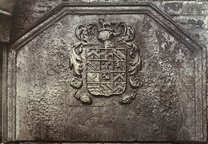

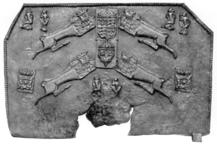
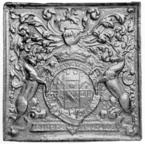
 23-10-12 686x.jpg)

